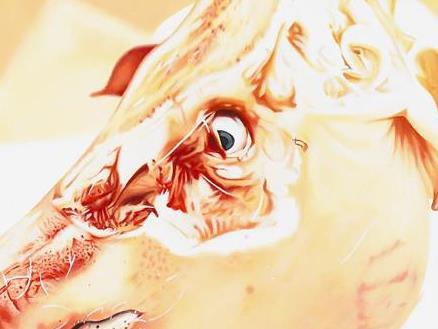Pig’s Head (1978), Ivan Durrant, Image from bengowing.com
With freedom of speech on the agenda as the Federal Government moves to repeal race hate provisions in the Racial Discrimination Act, the Human Rights Commissioner Tim Wilson said restrictions on freedom of expression were only justified when the expression conflicts with other rights.
‘I don’t think there should be any line on obscenity, because it’s not coming into conflict with any other rights in the same way with blasphemy. Whether they should or not is different matter. But whether there should be a legal limit or not–that’s not the same thing.’
There has not been a blasphemy case in Australia for more than a century and most blasphemy laws were abolished in the 1990s but obscenity laws have been implemented against artists in recent year on several occasions, including threats or charges against Paul Yore, the owners of the Dogs’ Bar in Melbourne and photographer Bill Henson.
ArtsHub Editor Deborah Stone made the comparison recently in Artists would prefer obscenity, Senator Brandis. ‘With the repeal of race hate laws, Australia is in the odd position of retaining antiquated obscenity restrictions on freedom of speech while repealing more modern restrictions, placed because of the needs of a tolerant and diverse society,’ she wrote.
The repeal of the 18C provisions of the Racial Discrimination Act removes restrictions that make it illegal to publicly express statements that are ‘reasonably likely…to offend, insult, humiliate or intimidate’ individuals or groups on grounds of ‘race, colour or national or ethnic origin’.Putting the repeal to Parliament last week Attorney General and Federal Arts Minister George Brandis drew strong reaction when he declared, ‘People do have the right to be bigots’.
Commissioner Wilson said one of the key misunderstandings about freedom of speech law was the expectation that the law should reflect acceptable standards of respectful discourse.
‘People seem to think wrongly that the line of acceptable conduct and the law is the same thing. They are not.’
He said the recent issues between Professor Marcia Langton and columnist Andrew Bolt were an example of the differences. ‘If people choose to apologise because they want to maintain healthy, harmonious relationships they are entitled to do that. There is nothing inconsistent with standing firmly for free speech, but also saying I demand an apology because what you have said has upset me and you’re either turning around and offering it because you agree with it and you recognise that you’ve caused a harm, or no, saying bugger off, I’m going to stand by what I’m going to say.’
He said artists were bound by the same limits on freedom of expression as everyone else in not breaching others’ freedoms but it was appropriate for them to push those boundaries.
‘Art is necessarily often a form of challenging social norms, which is precisely why we should have the line of law set at social norms, so that artists can challenge where we are in society. To inform it, to invoke responses, so that we can move our society forward.
‘Everybody has universal rights, which comes from a perspective where no one gets more rights than another person. So there is no inconsistency with the rights of audiences as there is with the rights of artists.’
Australian painter Ivan Durrant, infamous for the inherent shock value seen within many of his works agrees with Wilson that community standards of freedom of speech should not be limited. ‘I’m inclined to agree with his perspective. I’m kind of leaning towards his idea that we need absolute freedom to say things,’ he said.
Durrant, who faced obscenity charges in the 1970s said that social norms have evolved, referring to the controversial artworks of Damien Hirst, who controversially displayed dead animals in The Physical Impossibility of Death in the Mind of Someone Living. ‘Thirty five to forty years later, things change,’ he said.
But he said the line of what constitutes social norms is far from clear. ‘You’ll be surprised where the line is. The line can be anywhere. When something is done in the name of art, it always worries people a lot more, which is the reason why totalitarian regimes always decide to step on the artist first, because they feel that they can reach people.’
‘People get very antsy and upset about the idea of art challenging things. It’s a strange thing but that is what happens.’
Durrant has often challenged the boundaries of social acceptability within his work as an artist In 1995, he created live art performance Five women menstruating, in which he placed five fully clothed women at a kitchen table, surrounded by crockery he had smashed with a leg of lamb. ‘There was no relevance to the name of the event, but I wanted to associate bizarreness to the whole business,’ he said.
‘Of course there was complete outrage. The Benalla [City] Council said I could not use any council property whatsoever. There was a lot of outrage simply because I called this work “Five women menstruating”’.
‘Just to say menstruating within art, even if you weren’t showing everything did not seem to fit with the social norms. If you legislate for specific words or phrases, then you limit things. Taking as much away from legislating is the best idea,’ he said.
Durrant’s 1975 exhibition of Slaughtered Cow Happening, which saw him drape a freshly slaughtered cow on the forecourt of the National Gallery of Victoria landed him in court on six charges.
Evidently this case does show a relationship between the law and community standards. ‘They were happy to get me on just one [of the charges], which was dumping litter. I argued that art isn’t litter, but they wouldn’t accept that,’ he said.
Like Wilson, Durrant believes the role of the law and the question of social acceptability are very different. Changes to the Racial Discrimination Act may represent more freedom to artists but this does not mean that artists should exploit their freedoms.
‘Maybe some people will go over those lines, but it will have a good or bad effect depending on how people react to it. Art can make people react and enlighten them. If you become blatantly racist in a work of artist, it won’t enlighten people and people won’t respond to it.’





